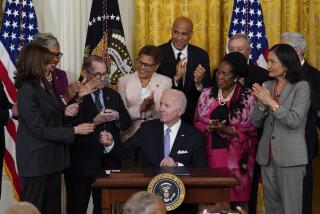Expand the Peace Corps
- Share via
When John F. Kennedy created the Peace Corps in 1961, it was embraced by Americans as a reflection of their national idealism. It took hold strongly and survived the end of the Cold War and federal budget-choppers, diminished but intact. Now President Clinton has proposed an expansion to 10,000 volunteers, well below its peak of 15,000 but a healthy increase from the current 6,600. It’s an idea with high rewards for low cost.
Peace Corps volunteers nowadays travel to the former Soviet Union and other former Eastern Bloc nations as well as Africa, Asia and Latin America. They are about to enter South Africa, with a project to improve science and math teaching. They work on small business formation, nutrition, maternal health, schooling and more. Worthy projects, but the biggest dividend may be America’s--citizens who return home with a sense of internationalism, self-reliance and civic responsibility. Ex-volunteers enter public life and do domestic volunteer work at higher than average rates.
True, the Peace Corps can’t solve the world’s problems. But on a budget of just $222 million, which Clinton would raise to $270 million in fiscal 1999, it presents the best face of this nation to the rest of the world. Volunteers are still generally in their 20s (there is no upper age limit), though job skills requiring experience, such as nursing, are more valued than they were at the beginning.
Clinton’s goal, 10,000 volunteers, is about right. In the early years, fast expansion left some volunteers without adequate jobs, and it was a scramble to find them all useful slots.
There’s no better time to strengthen the Peace Corps than now, with the U.S. buoyed by optimism. Share that outlook with the world, at a bargain price.
More to Read
Sign up for The Wild
We’ll help you find the best places to hike, bike and run, as well as the perfect silent spots for meditation and yoga.
You may occasionally receive promotional content from the Los Angeles Times.






